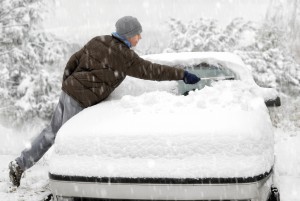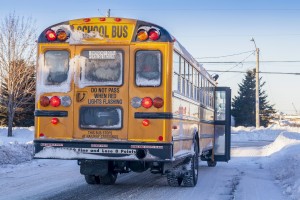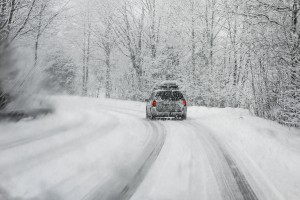- Clear snow and ice from all windows and lights – even the hood and roof- before driving

- Leave plenty of room for stopping.
- Pay attention don’t try to out drive the conditions. Remember the posted speed limits are for dry pavement.
- Use brakes carefully. Brake early. Brake correctly. It takes more time and distance to stop in adverse conditions.
- Bridge decks freeze first. Due to the difference in the exposure to air, the surface condition can be worse on a bridge than on the approach road.
- Exit ramps are an even greater challenge during the winter since they may have received less anti-icing material than the main line. Be aware of this when exiting the highway.
- Don’t use the “cruise control” option driving in wintry conditions. Even roads that appear clear can have sudden slippery spots and the slightest touch of your brakes to deactivate the cruise control can cause you to lose control of your vehicle.
- Don’t get overconfident in your 4×4 vehicle. Remember that, if you are driving a four wheel
 drive vehicle, the vehicle may help you get going quicker but it won’t help you stop any quicker. Many 4×4 vehicles are heavier than passenger vehicles and actually may take longer to stop. Don’t get overconfident in your 4×4 vehicle’s traction.
drive vehicle, the vehicle may help you get going quicker but it won’t help you stop any quicker. Many 4×4 vehicles are heavier than passenger vehicles and actually may take longer to stop. Don’t get overconfident in your 4×4 vehicle’s traction. - Look further ahead in traffic than you normally do. Actions by cars and trucks will alert you quicker to problems and give you a split-second extra time to react safely.
- Remember that trucks are heavier than cars. Trucks take longer to safely respond and come to a complete stop, so avoid cutting quickly in front of them.
- Leave room for maintenance vehicles and plows – stay back at least 200 feet and don’t pass on the right. (See additional information below.)
- Be careful for children getting on and off the school bus.
- Most importantly please remember to SLOW DOWN! Also, seat belts should be worn at all times – it’s the law.
Use Common Sense While Driving Near Plows

- Remember that the road in front of the plow is usually in much worse condition than the roadway behind the plow. Plows will typically travel under 35 miles per hour and there is always a temptation to pass them. For your safety, it is recommended that you stay a safe distance behind the snowplows.
- During plowing operations, visibility can be reduced by blowing snow and plow operators may need time to stop or move over to avoid stranded vehicles. Keeping a safe distance between your vehicle and the plow is very important in order to avoid accidents.
- Allow plenty of room when passing a snowplow. Do not cut back into the lane ahead of the plow too quickly since the blade extends several feet ahead of the truck. Some snowplows are equipped with a “wing plow,” a 10-12 foot extension off the side of the truck. Be aware that the hazard exists.
- When you see an approaching snow plow on an undivided roadway, move as far away from the center line as you safely can since blowing snow may obscure the actual width of the snowplow’s blade.
- Turn on your lights- to see and be seen. Brush the snow off your headlights and taillights frequently.
- Winter driving requires motorists to be careful and alert, but the most important tip for winter driving is: SLOW DOWN!
In Case You Are Stranded While Driving In Winter
- Call 911. If you have access to a telephone call 911 to summons help. In other states you may be able to call 911 or “O” to get the operator on the line. When you talk to authorities, be prepared to:
- Describe the location, condition of your companions and the trouble you are experiencing.
- Listen for questions.
- Follow any instruction. You may be told you should stay where you are to guide rescuers or to return to the scene.
- Do not hang up until you know who you have spoken with and what will happen next.
- Stay in your vehicle. Walking in a storm can be very dangerous. You can lose your way, wander out of reach, become exhausted, collapse and risk your life. Your vehicle itself is a good shelter.
- Avoid overexertion. Attempting to push your car, trying to jack it into a new position or
 shoveling snow takes great effort in storm conditions. You could risk heart attack or other injury.
shoveling snow takes great effort in storm conditions. You could risk heart attack or other injury. - Calm down and think. The storm will end and you will be found. Don’t work enough to get hot and sweaty. Wet clothing loses insulation quality making you more susceptible to the effects of hypothermia.
- Keep fresh air in your vehicle. It is much better to be chilly or cold and awake than to become comfortably warm and slip into unconsciousness. Freezing-wet or wind-driven snow can plug your vehicle’s exhaust system causing deadly carbon monoxide gas to enter your vehicle.
- Don’t run the engine-unless you are certain the exhaust pipe is free of snow or other objects. Keep the radiator free from snow to prevent the engine from overheating. Run the engine at 10 minute intervals for heat.
- Turn on the dome light at night, but only when running the engine.
- Keep your blood circulating freely by loosening tight clothing, changing positions frequently and moving your arms and legs. Huddle close to one another. Rub your hands together or put them under your armpits or between your legs. Remove your shoes occasionally and rub your feet.
- Don’t expect to be comfortable. The challenge is to survive until you’re found.
- Make yourself visible to rescuers. Tie a bright cloth to your antenna or door handle.
In Case You Are Involved In An Accident
- Check to see if anyone is injured.
- If necessary, call 911 and request an ambulance or emergency services.
- If possible, move your vehicle off the road.
- Exchange name, address, driver’s license number, vehicle registration, and insurance information with all drivers or property owners who are involved. You must show your driver’s license and registration if asked to do so.
- If you have damaged a parked vehicle or stationary property, you must try to locate the owner to report the accident or notify the police.
SOURCE: The Massachusetts Department of Transportation – Highway Division


